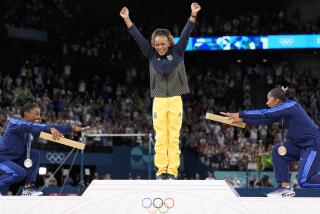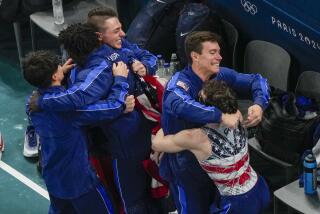As London Olympics approach, U.S. plays catch-up in triathlon
- Share via
There are at least two reasons why fans might expect the U.S. to excel in the Olympic triathlon.
First, this country is home to the sport’s best-known race, the famed Ironman competition in Hawaii.
Second, well, this is America.
“When you go to the Olympics, everyone expects a medal,” said Jarrod Shoemaker, who ranks among the nation’s best triathletes. “You win a medal and then you get invited to the Oprah show.”
But in the triathlon’s relatively short Olympic history, Americans have not fared so well, especially not the men, who have yet to stand on the podium.
And heading into a decisive qualifying race in San Diego this weekend, the prospects for success at the 2012 London Olympics remain decidedly hazy.
“Yeah,” said Matt Chrabot, another top competitor, “there’s a lot of pressure.”
The International Olympic Committee added triathlon to its lengthy roster of events in 2000. But it chose a version of the sport that differs greatly from the Ironman that people are used to watching on television.
The distances are significantly shorter, with a 1.5-kilometer swim, a 40-kilometer bicycle race and a 10-kilometer run instead of the marathon that caps the Hawaiian event.
Also, drafting is legal, which means cyclists can ride in packs, allowing teammates to help each other. That might help to explain why the Olympic triathlon is less predictable.
“When team tactics can be employed, there are a lot of variables,” said Andy Schmitz, the high performance general manager for the national squad. “There are a lot of surprises.”
None of which seem to have worked in the U.S. team’s favor at previous Games in Sydney, Athens or Beijing. Americans have collected only one medal — a bronze earned by Susan Williams in 2004.
“We’ve probably had some missed opportunities,” Schmitz said. “Athletes who were gold-medal favorites didn’t perform on the day.”
This time around, the women look to be in decent position with two racers — Gwen Jorgensen and Sarah Groff — already qualified and a third to be chosen soon.
For the men, 2011 was a rough year leading up to London.
They currently stand 10th in the national rankings, giving them only two of three potential slots at the Olympics. Barring unforeseen results in San Diego and at a later race in Madrid, that doesn’t figure to change.
“We need help from the countries we’re chasing,” Schmitz said. “It’s a pretty uphill battle.”
This weekend, Shoemaker and his compatriots face an international field in the Mission Beach area. The top American finisher will automatically qualify and if two Americans finish in the top nine, both will make the team. Otherwise, the second spot will be filled by discretionary selection.
No matter who winds up in London, they will have to confront unpleasant memories. At a qualifying event there last summer, they all struggled with a typical English downpour.
Shoemaker crashed on the cycling leg and Hunter Kemper fell ill during the run. Chrabot and Manny Huerta finished well behind the leaders.
“It was wet,” Shoemaker said. “We all had really bad races.”
Weather notwithstanding, the London course has earned high marks for its layout and ambience. The event will begin in Hyde Park and pass such landmarks as the Wellington Arch and Buckingham Palace.
The event should cause a stir in the city, thanks to the fact that England has two popular triathletes in brothers Alistair and Jonathan Brownlee.
British fans “understand the sport,” Shoemaker said. “There’s just going to be an awesome feeling and buzz in the crowd.”
The Americans will have to answer with the type of performance that has so far been lacking in Olympic competition.
“We’re going to have to be really fast,” Chrabot said. “And we might need a little bit of luck.”
twitter.com/LATimesWharton
More to Read
Go beyond the scoreboard
Get the latest on L.A.'s teams in the daily Sports Report newsletter.
You may occasionally receive promotional content from the Los Angeles Times.







